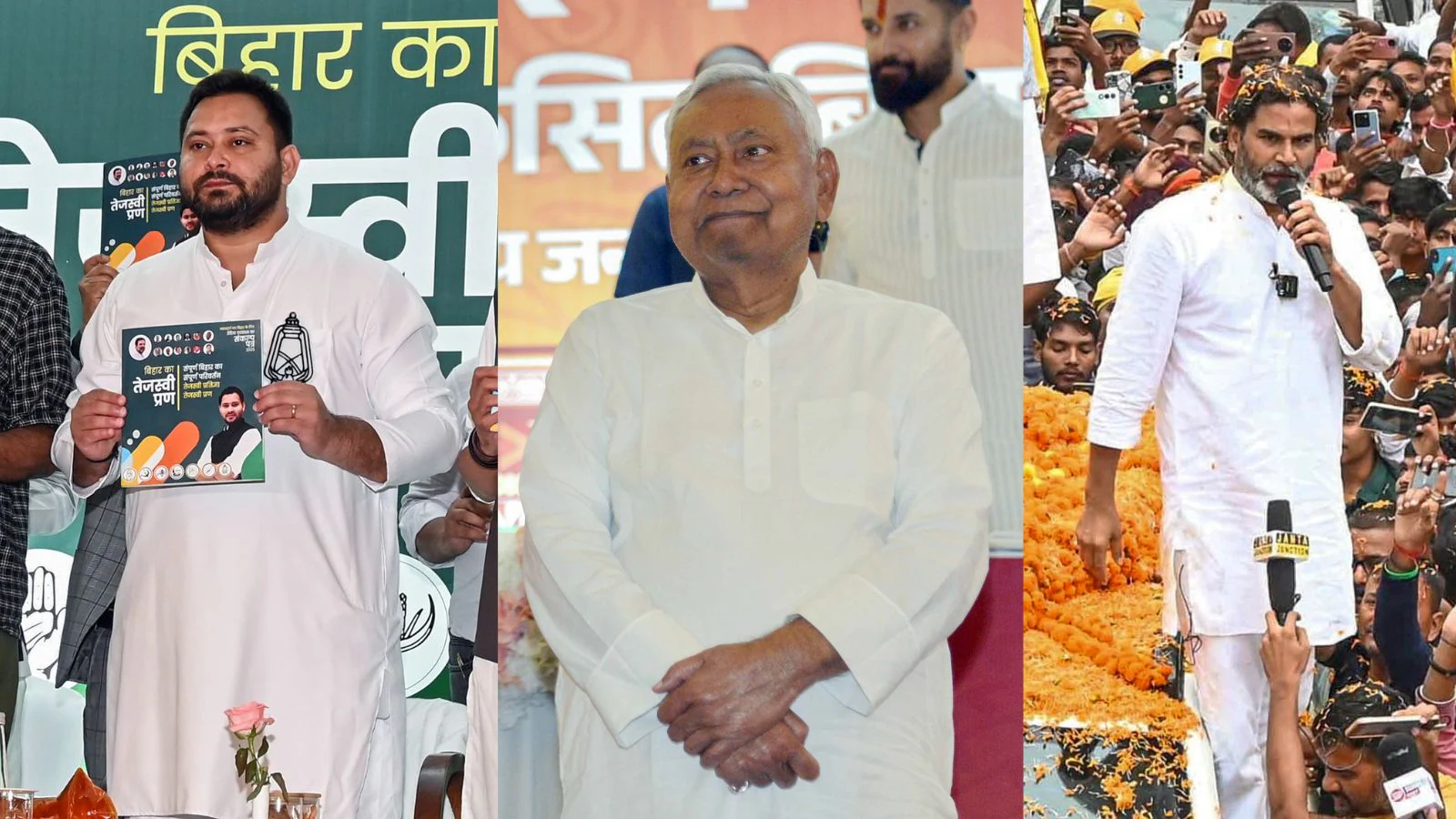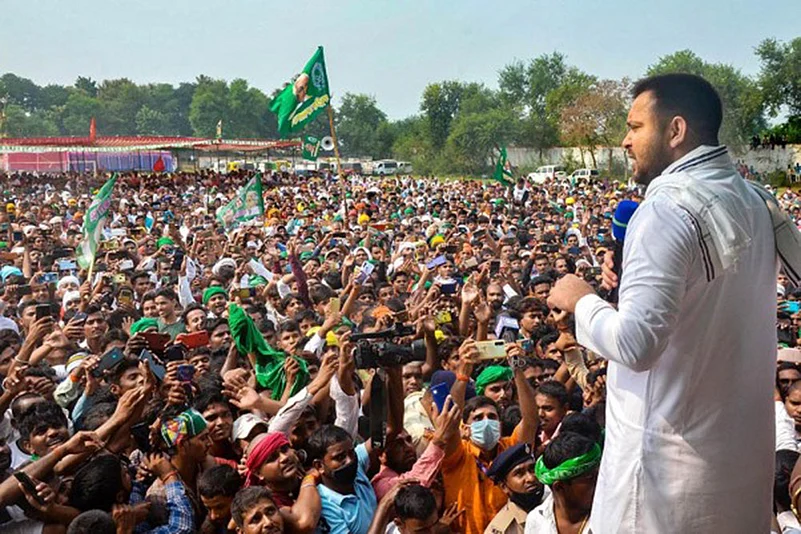As Bihar heads into its assembly elections in late 2025, the political moment is less an echo of previous contests and more a crossroads.
With over 130 million residents, Bihar is one of India’s most populous states, and among its most economically challenged. The electoral contest is no longer solely about caste arithmetic or alliance-churn; it has grown into a battle over livelihoods, migration, governance and legitimacy.
According to a March 2025 report from Niti Aayog, Bihar’s unemployment rate in 2022-23 stood at 3.9%, marginally above the national average of 3.2 per cent.
At the same time, the working-population ratio (WPR), the share of employed persons in the total population aged above a certain threshold, is alarmingly low: for the period July 2023 to June 2024, Bihar’s WPR was 33.5 per cent, compared to the all-India average of 43.7 per cent. Further, out-migration remains pervasive: some sources estimate up to 3 crore migrant workers originally from Bihar, engaged in work outside the state.
On the societal front, the dependency ratio, that is, the number of non-working to working persons, is particularly high in Bihar (66.3%) compared to the all-India average of 47.5 per cent.
What this means is: a smaller portion of the population is trying to shoulder the burden of a larger non-working segment. The combination of weak employment absorption, large migration and demographic pressure creates a recipe for political discontent.
What does this mean for the election?
In political-science terms, Bihar’s electorate is witnessing a shift in the binding logic of votes. Historically, identity politics, whether castes, sub-castes, or regional loyalties, dominated. But now the anchor of clientelism (jobs, transfers, local patronage) is colliding with structural deficits (few formal jobs, massive migration, shaky governance).

The result: promise-politics of welfare and jobs is supplanting, or at least mixing with, identity-based politics.
For example: one poll of Dalit voters found that over 71 per cent believed their votes might vanish due to the ongoing Special Intensive Revision (SIR) of electoral rolls. That suggests identity groups feel vulnerable not only economically but also institutionally, a sign of how governance, perception and identity intertwine.
Both major alliances recognise this. The ruling Bharatiya Janata Party/Janata Dal (United) (NDA) coalition emphasises welfare-schemes, stability and continuity. The opposition bloc, chiefly the Rashtriya Janata Dal (RJD)/Indian National Congress (INC) combine, is pitching structural job-creation and reversing migration. One campaign promise: “No Bihari will need to migrate for jobs.”
Youth turnout and first-time voters
Around 40% of Bihar’s electorate is estimated to be under the age of 30. Youth are more mobile, digitally connected, and sensitive to issues of employment and migration than older cohorts.
One poll found that among the 18-44 age group, anti-incumbency sentiment was over 45 per cent, higher than among older groups. If youth turnout jumps, it may favour parties who align their messaging with jobs and governance rather than old-style identity appeals.
Migration and regional vote shifts
The out-migration of thousands of young men to other states for work means that the decision-making often falls to women, older relatives or the remaining household. Reuters noted that a disproportionate number of votes will be cast by women because men are away in hubs like Mumbai and Delhi. A party that convincingly addresses migration (either via jobs or portable benefits) may capture a growing segment of this “left-behind” electorate.
Moreover, migration means households have “multi-location” linkages (origin in Bihar, livelihood outside). Political scientists describe these as translocal electorates, which complicates traditional vote-bank strategies rooted in local neighbourhood networks.
Implementation and credibility of promises
In the age of discernment, promises must show credible phasing and resource commitment to persuade swing voters. The RJD, for example, promises a law guaranteeing one government job per family; the NDA claims it has provided 12 lakh government jobs and plans to deliver one crore more.

The question is: who can convincingly demonstrate not just the promise, but the mechanism and timeline? Without that, expectations become sources of frustration, not mobilisation.
The concept of the “implementation deficit” comes alive here: when policy design (job guarantee, transfer payments, skill training) fails in execution (delayed payments, poor targeting, corruption), the legitimacy of parties erodes. Field reports from rural Bihar show youth queuing at job-fairs (“Maha Rojgar Mela”) who find mismatch between degrees and job postings.
The alliances and shifting terrain
The NDA arrangement in Bihar has reached an unusual parity between the BJP and JD(U) over seats contested, a sign of intra-alliance tensions and competing ambitions.
Meanwhile the opposition has a wildcard: the recently-formed Jan Suraaj (JS) party under Prashant Kishor. Though still nascent, JS has tried to pitch itself as a development-oriented alternative beyond caste calculus.




 Dr. Jaimine Vaishnav is a faculty of geopolitics and world economy and other liberal arts subjects, a researcher with publications in SCI and ABDC journals, and an author of 6 books specializing in informal economies, mass media, and street entrepreneurship. With over a decade of experience as an academic and options trader, he is keen on bridging the grassroots business practices with global economic thought. His work emphasizes resilience, innovation, and human action in everyday human life. He can be contacted on jaiminism@hotmail.co.in for further communication.
Dr. Jaimine Vaishnav is a faculty of geopolitics and world economy and other liberal arts subjects, a researcher with publications in SCI and ABDC journals, and an author of 6 books specializing in informal economies, mass media, and street entrepreneurship. With over a decade of experience as an academic and options trader, he is keen on bridging the grassroots business practices with global economic thought. His work emphasizes resilience, innovation, and human action in everyday human life. He can be contacted on jaiminism@hotmail.co.in for further communication.